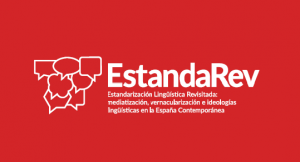Objetivos generales
- Analizar comparativamente las actitudes e ideologías lingüísticas de hablantes de diferentes variedades de español peninsular, catalán, gallego y euskera en torno a los procesos de estandarización de sus respectivas lenguas.
- Examinar la percepción social que genera en hablantes nativos de diferentes variedades de español peninsular, catalán, gallego y euskera el uso de variedades estándares y/o regionales en medios de comunicación orales de ámbito público.
- Verificar el alcance de la vernacularización, esto es, de mayor tolerancia hacia la variación lingüística, en las actitudes e ideologías lingüísticas de hispanohablantes, catalanohablantes, gallegohablantes y vascohablantes del territorio español.
Objetivos específicos
- Analizar la concepción y representación del constructo ‘estándar’ por parte de hablantes de español peninsular, catalán, gallego y euskera.
- Determinar los valores sociales que hablantes de distintas variedades de las 4 lenguas asignan a hablantes estándares y dialectales/vernaculares.
- Describir las actitudes e ideologías que manifiestan hablantes monolingües de español y hablantes bilingües de catalán, gallego y euskera ante la variación social y regional en los respectivos medios de comunicación.
- Identificar diferentes órdenes de indexicalidad de variantes lingüísticas que resultan prominentes perceptualmente en los procesos de categorización e indexación sociolingüística que llevan a cabo hablantes de las 4 lenguas, rasgos lingüísticos que tipifican a hablantes como ‘estándares’ o ‘dialectales/vernaculares’ de las respectivas lenguas peninsulares.
- Hallar las actitudes e ideologías que generan en hablantes de las 4 lenguas de 2 generaciones distintas la variación social y regional de los medios de comunicación orales seleccionados.
- Examinar la construcción discursiva de las variedades ‘estándares’ y ‘no estándares’ por parte de 2 generaciones distintas de hispanófonos, catalanófonos, gallegófonos y vascófonos del Estado español.
General aims
- Comparatively analyze the attitudes and linguistic ideologies of speakers of different varieties of peninsular Spanish, Catalan, Galician and Basque around the processes of standardization of their respective languages.
- Examine the social perception generated in native speakers of different varieties of peninsular Spanish, Catalan, Galician and Basque by the use of standard and/or regional varieties in public oral media.
- Verify the extent of vernacularization, that is, greater tolerance towards linguistic variation, in the attitudes and linguistic ideologies of Spanish, Catalan, Galician and Basque speakers of the Spanish territory.
Specific aims
- Analyze the conception and representation of the ‘standard’ construct by speakers of peninsular Spanish, Catalan, Galician and Basque.
- Determine the social values that speakers of different varieties of the 4 languages assign to standard and dialectal/vernacular speakers.
- Describe the attitudes and ideologies expressed by monolingual speakers of Spanish and bilingual speakers of Catalan, Galician and Basque in relation to social and regional variation in the respective media.
- Identify different orders of indexicality of linguistic variants that are perceptually prominent in the processes of categorization and sociolinguistic indexing carried out by speakers of the 4 languages, linguistic features that typify speakers as ‘standard’ or ‘dialectal/vernacular’ of the respective peninsular languages.
- Shed light on the attitudes and ideologies that the social and regional variation of the selected oral media generate in speakers of the 4 languages of 2 different generations.
- Examine the discursive construction of ‘standard’ and ‘non-standard’ varieties by 2 different generations of Spanish-speaking, Catalan-speaking, Galician-speaking and Basque-speaking Spanish speakers.




